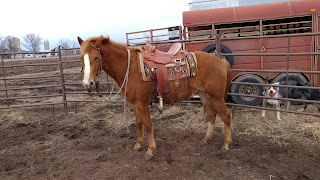Bringing you quality
horses scrupulously selected from the Appalachian foothills where the Rocky
Mountain horses thrive. Our horses have old foundation lineage that is true to
the origins of the breed. We exist to supply a growing demand for a quality gaited
horse, the Rocky Mountain Gaited Horse.
We are conveniently
located in the upper mid-west, about an hour from the closest airport in
Minneapolis, MN. Allow me to welcome
you an ease confidence and convenience when searching for your next lifetime
gaited Rocky partner!
An ideal Rocky, Smith's Ginger!
What are our
breeding initiatives and goals?
I apply several
concepts when it comes to producing foals or buying brood stock:
- Bodies
- Specially trained eye for confirmation, functionality and biomechanics. Horses that are built for a purpose and built to do it well!
- We don’t want our horses breaking down- we look for strong hooves, bones and balanced bodies to take the rider on a lifetime of adventures!
- Sound Minds
- Choose mares and stallions for calm, friendly personalities.
- Gentling techniques with foals magnify great personalities!
- We begin gentling foals and turn that early handling into a horse with the brightest future ever!
- Foals are imprinted and taught to lead, trim hooves and load in a trailer from the first weeks of life
- Gait and Performance
- Part of gait is in the genetics and training but great gait also results from proper confirmation and biomechanics!
- Gait is equally important as build and mind - it’s a trifecta, if we find a mare that may not be the best at one attribute we find a stallion to overcome that attribute, our foals are all 10's!
- The best genes for gaiting were passed on from the best foundation stock- we choose the best gaiting lineage. Individuals who gait well will produce the best offspring. Our mares and stallions are proven to the highest level of performance. The stronger the performance the stronger the gait
- Lots of research has gone into the pedigrees of our horses. We know history of sire's sire as well as great grandsires/great grand dams.
- Cross training- we take it to the next level, all aspects of performance are taken into consideration like an athlete training on their off season. i.e. the better a horse canters, turns, stops, goes the better the gait is able to develop and the best individuals are chosen to carry on their superior genes
- Did you know that the gait gene can be tested? A horse can carry one copy or two and guarantee passing on the best gait 100% of the time to the next generation.
- Knowledge of genetic mutations in the marketplace, we avoid these!
- Cosmetics
- Our stock has to be gorgeous! This encompasses pretty heads to 100% pretty packages. We do not want anything out of place when you look at our horses.
- Color is a fad and the last thing on our radar. The equine market drives this and we offer what is popular to our clients, but not letting the previous requirements out of the mix. Color is not our purpose… but…
- Our horses are stamped with beauty!
You will be proud to
own one!
The market
During economic
downfall both during the initial creation of the breed and during the last
decade, I found it difficult to obtain the best individuals. Many factors are
at play. I theorize that location, availability, promotion could be inhibiting
many breeders or owners from seeing the best of the breed. The owners and
breeders during the great depression culled many great foundation horses. The
breed was almost lost.
I often look at
photos of the foundation stallions and mares from Sam Tuttle to center myself
to what I desire for my herd. Outcrossing to other breeds has affected the RMHA
and I find that the gene pool I am looking for is too small. Some breeders do
not advertise and trips to the hills of Kentucky are needed to seek out the
best horses first hand. I am careful not to inbreed. I calculate inbreeding
coefficients to prevent my genes becoming too condensed. I also watch for
genetic disorders such as MCOA/ ASD to ensure the foals I produce have the
least chance of inheriting this genetic abnormality.






